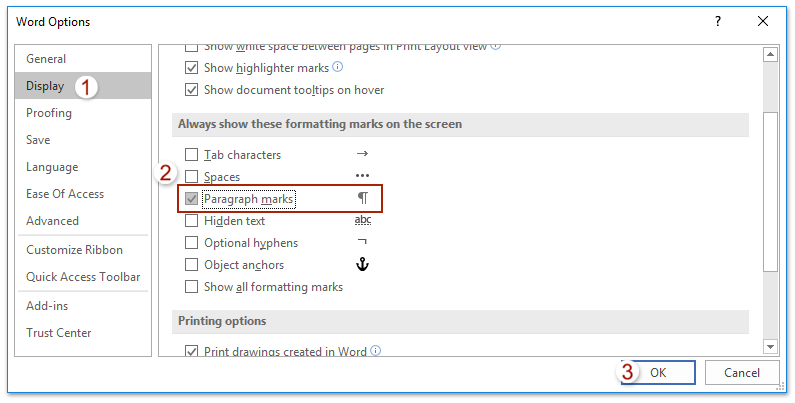

The seemingly random break between 23 and files. Finally I highlighted the same body text in both places.
#ON MS WORD FORMATTING MARKS ARE DISPLAYED AUTOMATICALY CODE#
Then I weeded through the XML to find the body code in that segment. The body text is at the top of this screen capture, I just grabbed a random section of the XML code and placed it below. Here is an example taken from the middle of a very short file Unlike WP, which just inserted the new codes required, Word inserts "all" of the formatting associated with a style. But Word has a tradition / history of generating really carpy HTML files. One of the files contains the body text embedded inside of XML formatting codes. In a small folder structure, that contains mostly XML format text files. The DOCX file is actually a renamed "ZIP" file format that contains the document content The (relatively) new "x-file" formats introduced in Office 2007, ie DOCX in Word, converted Office from MS "native" "binary" file formats to an underlying XML format. It is a great complement to MS’s inadequate attempt in the “Reveal Formatting” pane. This tool adds a pane that converts Word formatting into HTML/WordPefect like “codes”, displaying a WordPerfect like “Reveal Codes” pane. Displays an abbreviated version of the Reveal Formatting pane Style Inspector - display Style Pane, then click on middle button at bottom of the style pane. Reveal formatting - Displays the Reveal Formatting Pane showing all of the formatting on the selected text This is an excellent article describing all of the native Word tools for discovering formatting. Reveal Codes 3 in Word - Is there life after “Reveal Codes”?. Here are the articles that I have on recreating WP "reveal codes" in MS Word:Ĭhecking Formatting - Word's Reveal Codes But that presumes you have an idea of where the problem lies. There are some features in Word you can use to show paragraph and specific character formatting. Word is built to be "user friendly" by hiding all of the formatting codes. It sounds like what you are looking for is a "html" view where you can see all of the formatting codes, like WordPerfect used to do. All of the rest of the format information is not visible other than as the format displayed. Word has very few non printing characters that are visible. Many people, including us, want to see the XE fields but not the rest of the Show All stuff like spaces and paragraph marks.The lists, like the screen cap Nathan provided, are all there is. Show XE field codes but not other hidden text Hidden Text and The fields are automatically marked as Hidden Text (look for the dotted underlining). It’s the same behavior as Find/Replace/Go To or Insert | Symbol dialog boxes. You can then repeat the index entry process without having to constantly open and close the dialog box.

The Mark Index dialog box can stay open while you move through the document.Īfter marking one index entry, select another piece of text in your document without closing the “Mark Index Entry” dialog box. See inside your own soul Keep the Mark Index box open

It’s just a text label so you can type anything into the field such as:įirst Meeting. See Rainbow Lorikeets” without a page number.Ĭross-References don’t have to link with another part of the index. Or “Lorikeets” could be cross-referenced with “Rainbow Lorikeets”. For example, you could enter “Animals:Birds:Lorikeets” or “Sherlock Holmes:Reasoning:Explains“ to create a triple-tiered index entry. Type the entries (in either of the entry boxes) in hierarchical order separated by colons. The “Mark Index Entry” dialog box only has two boxes for entry levels, it actually allows for indexes to be up to seven layers deep if you want to get a little tricky. For example, “Lorikeets, 1, 7, 12” would mean that the term “Lorikeets” was marked on pages 1, 7 and 12. Mark Allīy clicking the “Mark All” button you are searching your document for every instance of the selected word/phrase and marking each occurrence as a separate page number (separated by commas) in the same index entry. Mark All – finds all instances of the selected text and indexes it. Mark – you are simply adding an index entry for the currently selected word into your index on the current page. The “Current page” option is also selected by default. The “Mark” and “Mark All” buttons are both available to you by default.


 0 kommentar(er)
0 kommentar(er)
